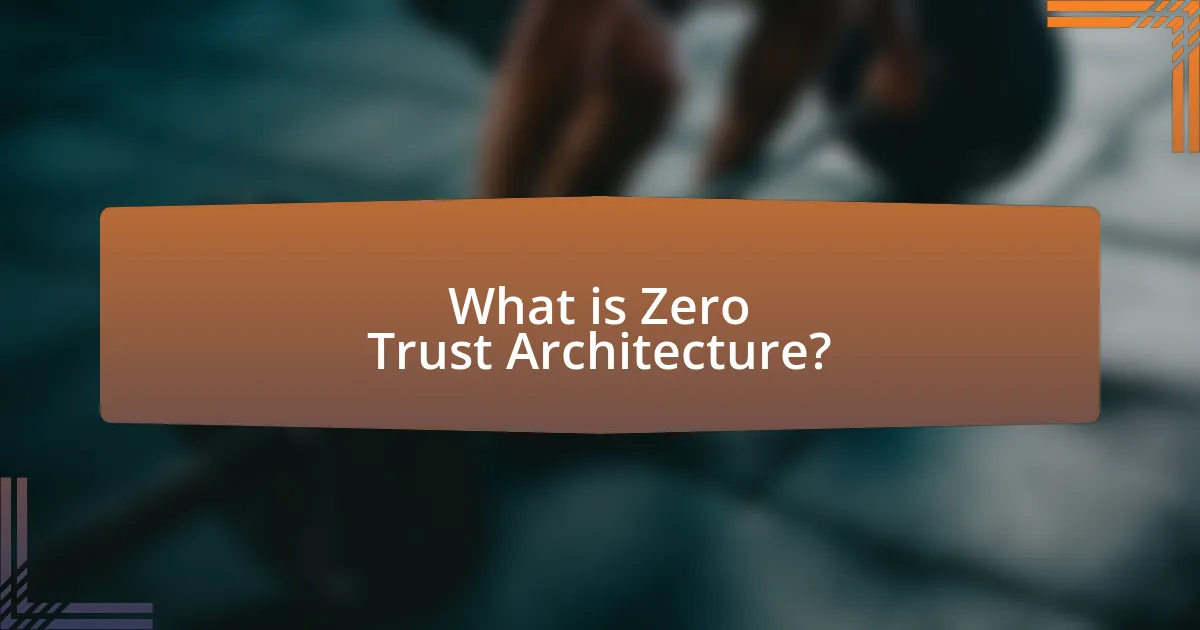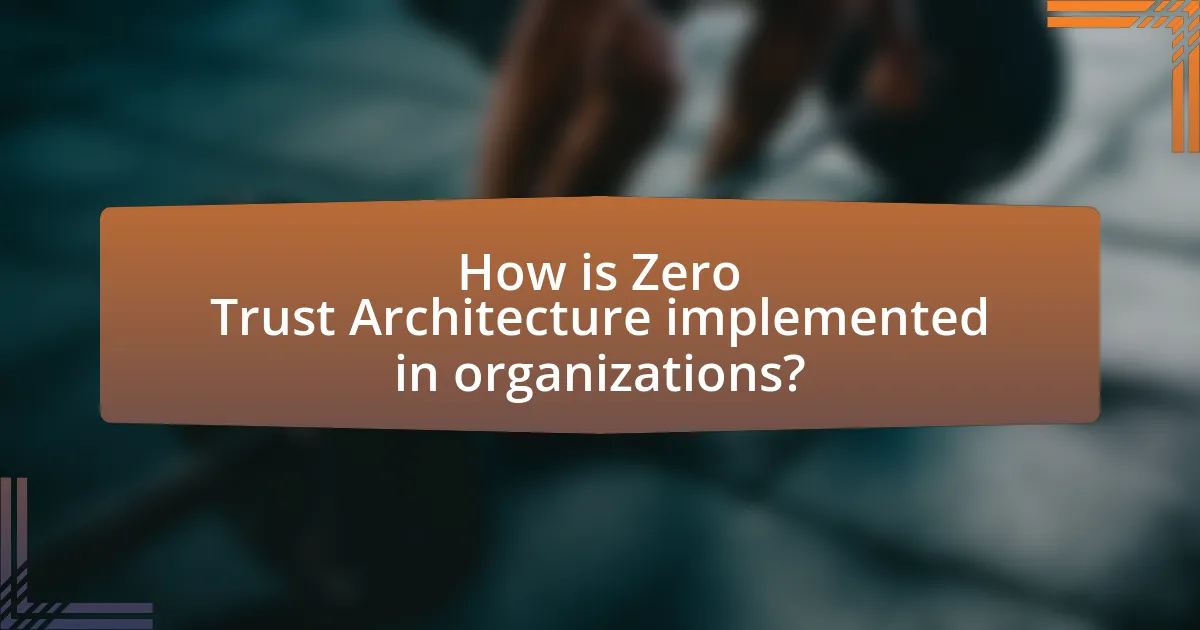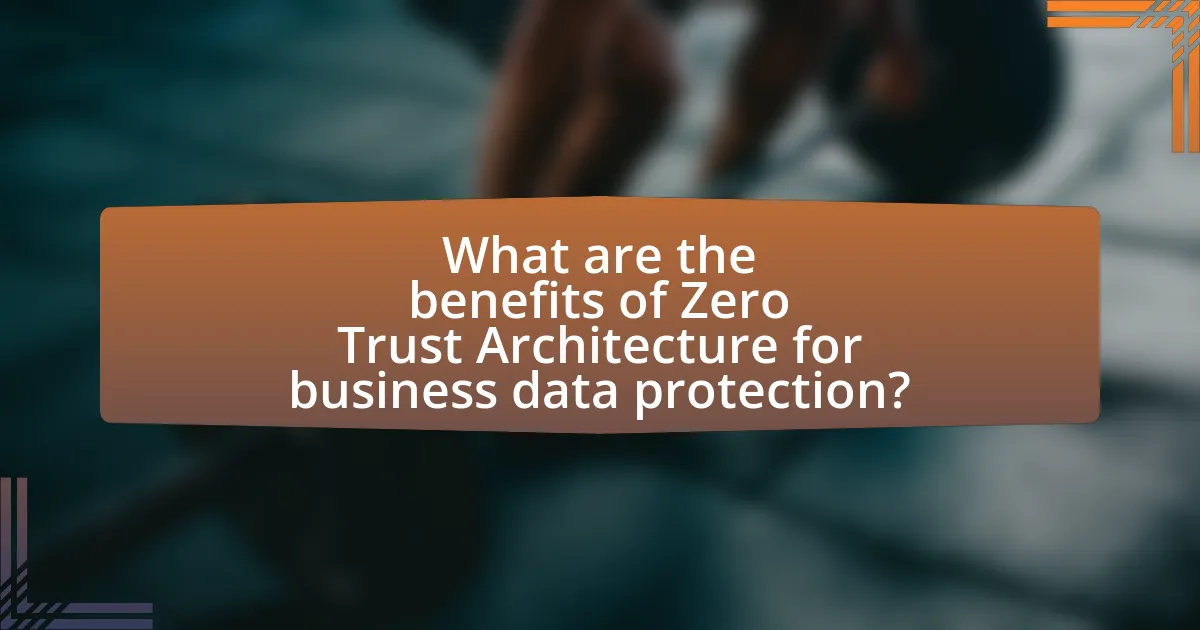Zero Trust Architecture is a cybersecurity model that mandates strict identity verification for all users and devices accessing network resources, regardless of their location. This approach contrasts with traditional security models by adopting a “never trust, always verify” philosophy, significantly reducing the risk of data breaches. Key principles of Zero Trust include continuous verification, least privilege access, and micro-segmentation, which collectively enhance security by limiting unauthorized access. The article explores the importance of Zero Trust in business data protection, its main components, the role of identity and access management, and the technologies that support its implementation, while also addressing the challenges organizations face during adoption and the long-term benefits of this security framework.

What is Zero Trust Architecture?
Zero Trust Architecture is a cybersecurity model that requires strict identity verification for every person and device attempting to access resources on a network, regardless of whether they are inside or outside the network perimeter. This approach is based on the principle that threats can originate from both external and internal sources, necessitating continuous authentication and authorization. According to a 2020 report by Forrester Research, organizations implementing Zero Trust can reduce the risk of data breaches by up to 50%, highlighting its effectiveness in enhancing business data protection.
How does Zero Trust Architecture differ from traditional security models?
Zero Trust Architecture fundamentally differs from traditional security models by adopting a “never trust, always verify” approach, which assumes that threats can exist both inside and outside the network. Traditional security models typically rely on perimeter defenses, where once a user or device is inside the network, they are trusted by default. In contrast, Zero Trust requires continuous verification of user identities and device security, regardless of their location, thereby minimizing the risk of unauthorized access. This model is supported by the increasing prevalence of data breaches, with a report from Cybersecurity Ventures predicting that global cybercrime damages will reach $10.5 trillion annually by 2025, highlighting the inadequacy of perimeter-based security.
What are the key principles of Zero Trust Architecture?
The key principles of Zero Trust Architecture are continuous verification, least privilege access, and micro-segmentation. Continuous verification ensures that all users and devices are authenticated and authorized before accessing resources, regardless of their location. Least privilege access limits user permissions to only what is necessary for their role, reducing the risk of insider threats and data breaches. Micro-segmentation involves dividing the network into smaller, isolated segments to contain potential breaches and limit lateral movement within the network. These principles collectively enhance security by assuming that threats can exist both inside and outside the network perimeter, thereby requiring strict access controls and constant monitoring.
Why is the concept of “never trust, always verify” crucial?
The concept of “never trust, always verify” is crucial because it establishes a security framework that minimizes the risk of data breaches and unauthorized access. In an era where cyber threats are increasingly sophisticated, relying solely on traditional perimeter defenses is inadequate. This principle mandates continuous verification of user identities and device integrity, ensuring that access to sensitive data is granted only after thorough authentication processes. For instance, according to a 2021 report by Cybersecurity Insiders, 70% of organizations adopting Zero Trust Architecture experienced a significant reduction in security incidents, highlighting the effectiveness of this approach in protecting business data.
What are the main components of Zero Trust Architecture?
The main components of Zero Trust Architecture include identity verification, device security, network segmentation, least privilege access, and continuous monitoring. Identity verification ensures that users are authenticated before accessing resources, while device security involves assessing the security posture of devices attempting to connect to the network. Network segmentation limits access to sensitive data by dividing the network into smaller, controlled segments. Least privilege access restricts user permissions to only what is necessary for their role, minimizing potential damage from breaches. Continuous monitoring involves real-time analysis of user behavior and network traffic to detect anomalies and respond to threats promptly. These components collectively enhance security by assuming that threats can exist both inside and outside the network perimeter.
How do identity and access management play a role in Zero Trust?
Identity and access management (IAM) is crucial in Zero Trust as it ensures that only authenticated and authorized users can access resources. In a Zero Trust model, IAM continuously verifies user identities and their access rights, regardless of their location within or outside the network perimeter. This approach minimizes the risk of unauthorized access and data breaches by enforcing strict access controls and monitoring user behavior. According to a report by Forrester Research, organizations implementing IAM within a Zero Trust framework can reduce security incidents by up to 50%, highlighting the effectiveness of IAM in enhancing data protection.
What technologies support the implementation of Zero Trust?
Technologies that support the implementation of Zero Trust include identity and access management (IAM), multi-factor authentication (MFA), micro-segmentation, endpoint security, and security information and event management (SIEM). IAM solutions ensure that only authorized users can access specific resources, while MFA adds an additional layer of security by requiring multiple forms of verification. Micro-segmentation divides networks into smaller, isolated segments to limit lateral movement of threats. Endpoint security protects devices that connect to the network, and SIEM provides real-time analysis of security alerts generated by applications and network hardware. These technologies collectively enhance security by enforcing strict access controls and continuously monitoring user behavior.
Why is Zero Trust Architecture important for business data protection?
Zero Trust Architecture is important for business data protection because it fundamentally shifts the security paradigm from a perimeter-based approach to one that assumes threats can exist both inside and outside the network. This model requires continuous verification of user identities and device security, ensuring that access to sensitive data is granted only to authenticated and authorized users. According to a 2021 report by Cybersecurity Insiders, 76% of organizations believe that adopting a Zero Trust model is essential for protecting their data against modern cyber threats. By implementing Zero Trust principles, businesses can significantly reduce the risk of data breaches and unauthorized access, thereby enhancing their overall security posture.
How does Zero Trust mitigate risks associated with data breaches?
Zero Trust mitigates risks associated with data breaches by enforcing strict access controls and continuous verification of user identities and devices. This approach ensures that no user or device is trusted by default, regardless of their location within or outside the network perimeter. By implementing micro-segmentation, Zero Trust limits lateral movement within the network, reducing the potential impact of a breach. Additionally, continuous monitoring and logging of user activities enable organizations to detect and respond to suspicious behavior in real-time, further minimizing the risk of data exposure. According to a study by Forrester Research, organizations that adopt Zero Trust can reduce the risk of data breaches by up to 50%, demonstrating its effectiveness in enhancing data security.
What impact does Zero Trust have on regulatory compliance?
Zero Trust significantly enhances regulatory compliance by ensuring that access to sensitive data is strictly controlled and monitored. This architecture requires continuous verification of user identities and device security, aligning with regulations such as GDPR and HIPAA that mandate stringent data protection measures. By implementing Zero Trust principles, organizations can demonstrate compliance through detailed access logs and real-time monitoring, which are essential for audits and regulatory reporting. Furthermore, the principle of least privilege inherent in Zero Trust minimizes the risk of data breaches, thereby reducing potential non-compliance penalties.

How is Zero Trust Architecture implemented in organizations?
Zero Trust Architecture is implemented in organizations by enforcing strict access controls and continuous verification of user identities and devices. This approach requires organizations to segment their networks, ensuring that users have access only to the resources necessary for their roles, thereby minimizing potential attack surfaces. Additionally, organizations utilize multi-factor authentication, encryption, and real-time monitoring to detect and respond to threats promptly. According to a 2021 report by Forrester Research, companies adopting Zero Trust principles have seen a 50% reduction in security breaches, demonstrating the effectiveness of this architecture in enhancing data protection.
What steps are involved in adopting Zero Trust Architecture?
The steps involved in adopting Zero Trust Architecture include defining the protection surface, mapping the transaction flows, architecting the Zero Trust network, implementing granular access controls, and continuously monitoring and improving the security posture.
First, organizations must identify the critical assets and data that need protection, which constitutes the protection surface. Next, mapping transaction flows helps understand how data moves across the network, identifying potential vulnerabilities. Following this, the architecture of the Zero Trust network is designed to enforce strict access controls and segmentation. Implementing granular access controls ensures that users have the minimum necessary access to perform their tasks, reducing the risk of insider threats. Finally, continuous monitoring and improvement are essential to adapt to evolving threats and ensure the effectiveness of the Zero Trust model.
These steps are validated by industry frameworks such as the NIST Cybersecurity Framework, which emphasizes the importance of continuous assessment and adaptation in security practices.
How can organizations assess their current security posture?
Organizations can assess their current security posture by conducting comprehensive security assessments, including vulnerability assessments, penetration testing, and security audits. These evaluations help identify weaknesses in systems, processes, and policies. For instance, a 2021 report by Cybersecurity Ventures indicated that 60% of small businesses experienced a cyber attack, highlighting the need for regular assessments to mitigate risks. Additionally, organizations can utilize frameworks such as the NIST Cybersecurity Framework, which provides guidelines for managing and reducing cybersecurity risk, further validating the effectiveness of their security posture assessment.
What role does employee training play in Zero Trust implementation?
Employee training is crucial in Zero Trust implementation as it ensures that all personnel understand security protocols and their responsibilities in maintaining a secure environment. Effective training programs educate employees on identifying potential threats, adhering to access controls, and recognizing the importance of verifying identities before granting access to sensitive data. Research indicates that organizations with comprehensive security training programs can reduce the risk of security breaches by up to 70%, highlighting the direct impact of informed employees on the overall security posture.
What challenges do organizations face when implementing Zero Trust?
Organizations face several challenges when implementing Zero Trust, primarily including complexity in integration, cultural resistance, and resource allocation. The complexity arises from the need to overhaul existing security architectures and integrate various technologies, which can lead to operational disruptions. Cultural resistance is often encountered as employees may be reluctant to adapt to new security protocols that require continuous verification of identity and access. Additionally, resource allocation becomes a challenge, as organizations must invest in new tools, training, and ongoing management to effectively implement and maintain a Zero Trust framework. According to a 2022 report by Cybersecurity Insiders, 70% of organizations cited resource constraints as a significant barrier to adopting Zero Trust strategies.
How can organizations overcome resistance to change?
Organizations can overcome resistance to change by fostering a culture of open communication and involving employees in the change process. Engaging employees through transparent discussions about the reasons for change and the benefits it brings can reduce anxiety and build trust. Research indicates that organizations that actively involve their workforce in decision-making processes experience a 70% higher success rate in implementing change initiatives. Additionally, providing training and support helps employees adapt to new systems, such as Zero Trust Architecture, which enhances data protection and security. By addressing concerns and equipping staff with the necessary skills, organizations can effectively mitigate resistance and facilitate smoother transitions.
What are common pitfalls during the Zero Trust adoption process?
Common pitfalls during the Zero Trust adoption process include inadequate planning, lack of stakeholder buy-in, and insufficient integration with existing systems. Inadequate planning often leads to misalignment between security goals and business objectives, resulting in ineffective implementation. Lack of stakeholder buy-in can hinder the necessary cultural shift, as employees may resist changes to established workflows. Insufficient integration with existing systems can create gaps in security coverage, as legacy systems may not support Zero Trust principles. These pitfalls can significantly undermine the effectiveness of a Zero Trust strategy, as evidenced by reports indicating that organizations with clear planning and stakeholder engagement are more successful in their security transformations.

What are the benefits of Zero Trust Architecture for business data protection?
Zero Trust Architecture enhances business data protection by ensuring that no user or device is trusted by default, regardless of their location. This model significantly reduces the risk of data breaches by implementing strict access controls and continuous verification of user identities and device health. According to a report by Forrester Research, organizations that adopt Zero Trust can reduce the risk of data breaches by up to 50%. Additionally, Zero Trust Architecture employs micro-segmentation, which limits lateral movement within the network, further safeguarding sensitive data. This approach not only protects against external threats but also mitigates risks from insider threats, making it a comprehensive strategy for modern data security.
How does Zero Trust enhance data security?
Zero Trust enhances data security by implementing a strict verification process for every user and device attempting to access resources, regardless of their location. This approach minimizes the risk of unauthorized access and data breaches by assuming that threats could exist both inside and outside the network perimeter. According to a 2021 report by Cybersecurity Insiders, organizations that adopted Zero Trust saw a 50% reduction in security breaches, demonstrating its effectiveness in protecting sensitive data.
What specific threats does Zero Trust help to address?
Zero Trust helps to address specific threats such as insider threats, data breaches, and advanced persistent threats (APTs). By implementing strict access controls and continuous verification of user identities, Zero Trust minimizes the risk of unauthorized access to sensitive data. According to a report by Forrester Research, organizations adopting Zero Trust can reduce the likelihood of data breaches by up to 50%, demonstrating its effectiveness in mitigating these threats.
How does Zero Trust improve incident response times?
Zero Trust improves incident response times by ensuring that security protocols are continuously enforced and monitored, regardless of the user’s location or device. This architecture minimizes the attack surface by requiring strict identity verification for every access request, which allows security teams to quickly identify and isolate threats. According to a study by Forrester Research, organizations implementing Zero Trust can reduce the time to detect and respond to incidents by up to 50%, as the model provides real-time visibility and control over user activities and data access. This proactive approach enables faster remediation and containment of security incidents, ultimately enhancing overall incident response efficiency.
What are the long-term advantages of adopting Zero Trust?
The long-term advantages of adopting Zero Trust include enhanced security, reduced risk of data breaches, and improved compliance with regulations. By implementing a Zero Trust model, organizations enforce strict access controls and continuously verify user identities, which significantly lowers the likelihood of unauthorized access. According to a study by Forrester Research, companies that adopt Zero Trust can reduce the risk of data breaches by up to 50%. Additionally, Zero Trust frameworks facilitate compliance with data protection regulations such as GDPR and HIPAA by ensuring that sensitive data is only accessible to authorized users, thus promoting a culture of security within the organization.
How does Zero Trust contribute to a culture of security within organizations?
Zero Trust contributes to a culture of security within organizations by enforcing strict access controls and continuous verification of user identities. This approach minimizes the risk of unauthorized access and data breaches, as it requires users to authenticate themselves for every access request, regardless of their location within the network. According to a study by Forrester Research, organizations implementing Zero Trust can reduce the risk of data breaches by up to 50%, demonstrating its effectiveness in fostering a security-focused environment. By prioritizing security at every level, Zero Trust encourages employees to adopt security best practices, thereby embedding a culture of vigilance and accountability throughout the organization.
What cost savings can be realized through Zero Trust implementation?
Zero Trust implementation can lead to significant cost savings by reducing the risk of data breaches and minimizing the expenses associated with incident response and recovery. According to a study by the Ponemon Institute, organizations that adopt a Zero Trust model can save an average of $1.5 million per data breach due to enhanced security measures that prevent unauthorized access. Additionally, Zero Trust reduces the need for extensive perimeter security infrastructure, allowing businesses to allocate resources more efficiently and lower operational costs. By streamlining security protocols and reducing the attack surface, companies can also decrease the frequency and severity of security incidents, further contributing to overall cost savings.
What best practices should organizations follow when implementing Zero Trust?
Organizations should follow several best practices when implementing Zero Trust, including defining a clear security perimeter, continuously verifying user identities, and segmenting network access. Establishing a security perimeter involves identifying sensitive data and resources, ensuring that access is granted based on the principle of least privilege. Continuous verification of user identities requires implementing multi-factor authentication and monitoring user behavior to detect anomalies. Network segmentation limits access to critical systems, reducing the attack surface and containing potential breaches. According to a 2021 Forrester report, organizations that adopted Zero Trust saw a 50% reduction in security incidents, demonstrating the effectiveness of these practices in enhancing data protection.
How can organizations continuously monitor and adapt their Zero Trust strategies?
Organizations can continuously monitor and adapt their Zero Trust strategies by implementing real-time analytics and automated threat detection systems. These systems enable organizations to assess user behavior, network traffic, and access patterns continuously, allowing for immediate adjustments to security policies based on emerging threats. For instance, according to a report by Forrester Research, organizations that utilize automated monitoring tools can reduce the time to detect and respond to security incidents by up to 90%. Additionally, regular audits and assessments of security controls, combined with user feedback and threat intelligence, further enhance the adaptability of Zero Trust frameworks, ensuring they remain effective against evolving cyber threats.
What tools and resources are available to support Zero Trust initiatives?
Tools and resources available to support Zero Trust initiatives include identity and access management (IAM) solutions, network segmentation tools, and continuous monitoring systems. IAM solutions, such as Okta and Microsoft Azure Active Directory, enable organizations to enforce strict access controls based on user identity and context. Network segmentation tools, like VMware NSX and Cisco ACI, help isolate sensitive data and applications, reducing the attack surface. Continuous monitoring systems, including Splunk and Palo Alto Networks, provide real-time visibility into network traffic and user behavior, allowing for rapid detection of anomalies. These tools collectively enhance security by ensuring that only authenticated users can access specific resources, thereby aligning with the core principles of Zero Trust architecture.
